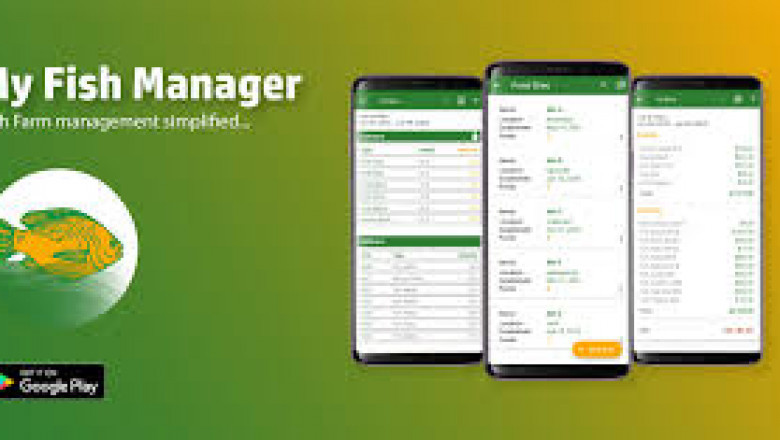views
Introduction
In modern aquaculture, maximizing efficiency while maintaining sustainability is not just a goal — it's a necessity. One of the key metrics that aquaculture operators monitor is the Feed Conversion Ratio (FCR), a measure of how efficiently fish convert feed into body mass. Poor feed management not only leads to wasted resources but also increases operational costs and environmental impact.
Enter Fish Farm Management Software — a digital innovation designed to optimize every aspect of fish farming, from feeding schedules to water quality control. In this article, we'll explore how this software can significantly improve FCR, reduce waste, and enhance profitability.
What is Feed Conversion Ratio (FCR) in Fish Farming?
Feed Conversion Ratio (FCR) is calculated as:
FCR = Feed Intake (kg) / Weight Gain (kg)
In simpler terms, it measures how many kilograms of feed are needed to produce one kilogram of fish weight.
An ideal FCR is below 1.5 for most farmed species, although this can vary depending on species, farming methods, and environmental factors (FAO, 2022).
Poor FCR can result from:
-
Overfeeding
-
Underfeeding
-
Poor feed quality
-
Unoptimized feeding schedules
-
Environmental stressors like low oxygen or poor water quality
Challenges with Traditional Fish Farm Management
Traditionally, fish farm management relied heavily on manual records, human observations, and guesswork. Some critical problems with this approach include:
-
Inaccurate Data Recording: Manual errors lead to wrong feed quantity estimations.
-
Reactive Decision Making: Managers only adjust when they notice issues, often too late.
-
Waste Accumulation: Overfeeding results in feed sinking to the bottom, polluting ponds.
-
Inconsistent Monitoring: Environmental variables (temperature, pH, oxygen) aren't continuously monitored.
These inefficiencies drive up feed costs — which can represent up to 70% of a fish farm’s operating expenses (World Bank, 2021).
How Fish Farm Management Software Transforms Feed Efficiency
These Farm Management Software integrates real-time data analytics, IoT sensors, machine learning, and predictive modeling to streamline fish farm operations. Here's how it directly impacts FCR and waste reduction:
1. Automated Feeding Schedules
The software can automate feeding based on:
-
Fish species
-
Size and growth phase
-
Temperature
-
Dissolved oxygen levels
Automation reduces human error and ensures that fish are fed the right amount at the right time, improving feed uptake and minimizing leftovers.
Case Study:
A study published by the Journal of Aquaculture (2023) reported a 12% improvement in FCR in tilapia farms using automated feeding systems compared to manually fed operations.
2. Real-Time Environmental Monitoring
IoT-connected sensors integrated with these farm management software monitor critical parameters like:
-
Water temperature
-
pH levels
-
Dissolved oxygen
-
Ammonia levels
Maintaining optimal water quality reduces fish stress and improves feeding behavior, leading to better growth rates and lower mortality.
Data Point:
Maintaining dissolved oxygen above 5 mg/L can improve feed efficiency by up to 15% in salmon farms (FAO, 2021).
3. Predictive Analytics for Feeding Optimization
Advanced algorithms analyze past feeding behavior, environmental conditions, and fish growth patterns to predict optimal feeding amounts and times.
Benefits include:
-
Preventing overfeeding during low-oxygen periods
-
Adjusting feed type/formulation based on growth stage
-
Avoiding feed waste during cold spells when fish metabolism slows down
Statistic:
Farmers using predictive analytics reported a 20–25% reduction in feed waste in trials conducted by the Aquaculture Stewardship Council (ASC, 2022).
4. Inventory and Stock Management
Managing feed inventory through the software prevents:
-
Overstocking (leading to expired feed)
-
Understocking (causing feeding interruptions)
You can track consumption trends, predict procurement needs, and even integrate with suppliers for seamless restocking.
5. Data-Driven Decision Making
The software generates customized reports on:
-
Feed conversion trends
-
Daily feed rates
-
Growth projections
-
Mortality rates
Farmers can make proactive adjustments rather than waiting for visible problems to arise.
Commercial Keywords and Benefits for Aquaculture Businesses
Using Farm Management Software offers several commercial advantages:
-
Reduced Feed Costs: With optimized FCR, farmers save substantially on feed expenses.
-
Higher Yields: Better growth rates result in faster harvest cycles.
-
Improved Environmental Compliance: Less waste means lower environmental impact, crucial for meeting regulatory standards.
-
Enhanced Sustainability: Better resource management aligns with eco-certification requirements (e.g., GlobalG.A.P., ASC).
This makes fish farm management software a must-have investment for scaling and future-proofing aquaculture operations.
Leading Fish Farm Management Software Providers
Some popular solutions include:
-
Aquanetix: Specializes in real-time monitoring and data-driven feeding.
-
eFishery: Offers smart feeders integrated with mobile management.
-
XpertSea: Focuses on shrimp farming with AI-powered growth tracking.
-
Aquabyte: Provides AI-based biomass estimation and feeding optimization for salmon farms.
Choosing the right platform depends on species, farm size, and local conditions.
FAQs
1. How much can these farm management software improve feed efficiency?
Studies show improvements between













Comments
0 comment